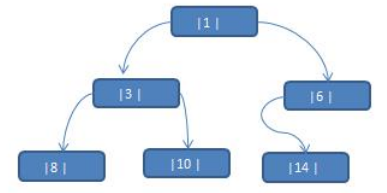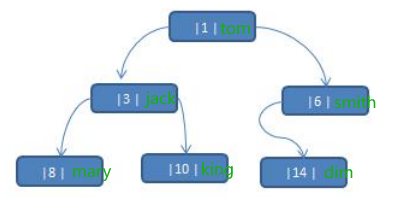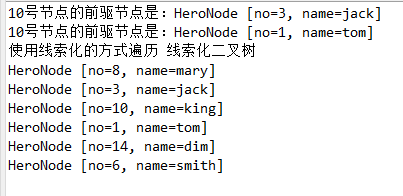【数据结构(九)】线索化二叉树(3)
2023-12-13 08:52:25
1. 前言——问题引出
????
问题:
????将数列 {1, 3, 6, 8, 10, 14 } 构建成一颗二叉树. (n+1=7个空指针域)

????
问题分析:
1.当对上面的二叉树进行中序遍历时,数列为 {8, 3, 10, 1, 6, 14 }
2.但是 6 的 右指针,8、10、14 这几个节点的 左右指针,并没有完全的利用上(共7个空指针域)
3.如果希望充分的利用 各个节点的左右指针,让各个节点可以指向自己的前后节点,怎么办?
????
解决方案:线索二叉树
2. 线索二叉树的基本介绍

- n n n 个结点的二叉链表中含有 n + 1 n+1 n+1 【公式 2 n ? ( n ? 1 ) = n + 1 2n-(n-1)=n+1 2n?(n?1)=n+1】 个空指针域。利用二叉链表中的空指针域,存放指向该结点在某种遍历次序下的前驱和后继结点的指针(这种附加的指针称为"线索")。
- 这种加上了线索的二叉链表称为线索链表,相应的二叉树称为线索二叉树(Threaded BinaryTree)。根据线索性质的不同,线索二叉树可分为前序线索二叉树、中序线索二叉树和后序线索二叉树三种。
- 一个结点的前一个结点,称为前驱结点。
- 一个结点的后一个结点,称为后继结点。
3. 线索二叉树的应用案例
应用案例说明:
????将下面的二叉树,进行中序线索二叉树。中序遍历的数列为 {8, 3, 10, 1, 14, 6}

3.1. 思路分析
中序遍历的结果:{8, 3, 10, 1, 14, 6}

说明:
当线索化二叉树后,Node节点的 属性left和right,有如下情况:
(1)left指向的是左子树,也可能是指向的前驱节点,比如 “1节点” 的left 指向的左子树, 而 “10节点” 的 left 指向的就是前驱节点.
(2)right指向的是右子树,也可能是指向后继节点,比如 “1节点” 的right 指向的是右子树,而 “10节点” 的right 指向的是后继节点.
3.2. 代码实现
package tree.threadedbinarytree;
//import tree.HeroNode;
public class ThreadedBinaryTreeDemo {
public static void main(String[] args) {
HeroNode root = new HeroNode(1, "tom");
HeroNode node2 = new HeroNode(3, "jack");
HeroNode node3 = new HeroNode(6, "smith");
HeroNode node4 = new HeroNode(8, "mary");
HeroNode node5 = new HeroNode(10, "king");
HeroNode node6 = new HeroNode(14, "dim");
// 二叉树,这里手动创建方法比较低级,后面要学习递归创建
root.setLeft(node2);
root.setRight(node3);
node2.setLeft(node4);
node2.setRight(node5);
node3.setLeft(node6);
// 测试线索化
ThreadedBinaryTree threadedBinaryTree = new ThreadedBinaryTree();
threadedBinaryTree.setRoot(root);
threadedBinaryTree.threadedNodes();
// 测试,以10节点测试
HeroNode leftNode = node5.getLeft();
System.out.println("10号节点的前驱节点是:" + leftNode);
HeroNode rightNode = node5.getRight();
System.out.println("10号节点的前驱节点是:" + rightNode);
}
}
//
//编写一个ArrayBinaryTree,实现顺序存储二叉树遍历
//定义一个ThreadedBinaryTree,实现了线索化功能的二叉树
class ThreadedBinaryTree {
private HeroNode root;
// 为了实现线索化,需要创建要指向当前节点的前驱节点的指针
// 在递归进行线索化时,pre 总是保留前一个节点
private HeroNode pre = null;
public void setRoot(HeroNode root) {
this.root = root;
}
// 重载
public void threadedNodes() {
this.threadedNodes(root);
}
// 编写对二叉树进行中序线索化的方法
/**
*
* @param node 就是当前需要线索化的节点
*/
public void threadedNodes(HeroNode node) {
// 如果node==null,不能线索化
if (node == null) {
return;
}
// 1. 先线索化左子树
threadedNodes(node.getLeft());
// 2. 然后线索化当前节点[有难度]
// 先处理当前节点的前驱节点
// 以8节点来理解
// 8节点的.left=null, 8节点的.leftType=1
if (node.getLeft() == null) {
// 让当前节点的左指针指向前驱节点
node.setLeft(pre);
// 修改当前节点的左指针的类型
node.setLeftType(1);
}
// 处理后继结点
if (pre != null && pre.getRight() == null) {
// 让前驱节点的有指针指向当前节点
pre.setRight(node);
// 修改前驱节点的有指针类型
pre.setRightType(1);
}
// !!!每处理一个节点后,让当前节点是下一个节点的前驱节点
pre = node;
// 3. 再线索化右子树
threadedNodes(node.getRight());
}
// 删除节点
public void delNode(int no) {
if (root != null) {
// 如果只有一个root节点,这里立即判断root是不是就是要删除的节点
if (root.getNo() == no) {
root = null;
} else {
// 递归删除
root.delNode(no);
}
} else {
System.out.println("空数,不能删除~");
}
}
// 前序遍历
public void preOrder() {
if (this.root != null) {
this.root.preOrder();
} else {
System.out.println("二叉树为空,无法遍历");
}
}
// 中序遍历
public void infixOrder() {
if (this.root != null) {
this.root.infixOrder();
} else {
System.out.println("二叉树为空,无法遍历");
}
}
// 后序遍历
public void postOrder() {
if (this.root != null) {
this.root.postOrder();
} else {
System.out.println("二叉树为空,无法遍历");
}
}
// 前序遍历查找
public HeroNode preOrderSearch(int no) {
if (root != null) {
return root.preOrderSearch(no);
} else {
return null;
}
}
// 中序遍历
public HeroNode infixOrderSearch(int no) {
if (root != null) {
return root.infixOrderSearch(no);
} else {
return null;
}
}
// 后序遍历
public HeroNode postOrderSearch(int no) {
if (root != null) {
return this.root.postOrderSearch(no);
} else {
return null;
}
}
}
//创建HeroNode
//先创建HeroNode节点
class HeroNode {
private int no;
private String name;
private HeroNode left;// 默认null
private HeroNode right;// 默认null
// 说明
// 1. 如果leftType == 0 表示指向的是左子树,如果1 则表示指向前驱节点
// 2. 如果rightType == 0 表示指向的是右子树,如果1 则表示指向后继结点
private int leftType;
private int rightType;
public int getLeftType() {
return leftType;
}
public void setLeftType(int leftType) {
this.leftType = leftType;
}
public int getRightType() {
return rightType;
}
public void setRightType(int rightType) {
this.rightType = rightType;
}
public HeroNode(int no, String name) {
super();
this.no = no;
this.name = name;
}
public int getNo() {
return this.no;
}
public void setNo(int no) {
this.no = no;
}
public String getName() {
return this.name;
}
public void setName(String name) {
this.name = name;
}
public HeroNode getLeft() {
return this.left;
}
public void setLeft(HeroNode left) {
this.left = left;
}
public HeroNode getRight() {
return this.right;
}
public void setRight(HeroNode right) {
this.right = right;
}
@Override
public String toString() {
return "HeroNode [no=" + no + ", name=" + name + "]";
}
// 递归删除节点
// 1. 如果删除的节点是叶子节点,则删除该节点
// 2. 如果删除的节点是非叶子节点,则删除该子树
public void delNode(int no) {
// 思路
/*
* 1.因为我们的二叉树是单向的,所以我们是判断当前节点的子节点是否需要删除结点,而不能去判断当前这个节点是不是需要删除节点。
* 2.如果当前节点的左子节点不为空,并且左子节点就是要删除节点,就将this.left=null,并且就返回(结束递归删除)
* 3.如果当前节点的右子节点不为空,并且右子节点就是要删除节点,就将this.right=null,并且就返回(结束递归删除)
* 4.如果第2和第3步没有删除节点,那么就需要向左子树进行递归删除 5.如果第4步也没有删除节点,则应当向右子树进行递归删除
*/
// 2.如果当前节点的左子节点不为空,并且左子节点就是要删除节点,就将this.left=null,并且就返回(结束递归删除)
if (this.left != null && this.left.no == no) {
this.left = null;
return;
}
// 3.如果当前节点的右子节点不为空,并且右子节点就是要删除节点,就将this.right=null,并且就返回(结束递归删除)
if (this.right != null && this.right.no == no) {
this.right = null;
return;
}
// 4.如果第2和第3步没有删除节点,那么就需要向左子树进行递归删除
if (this.left != null) {
this.left.delNode(no);
}
// 5.如果第4步也没有删除节点,则应当向右子树进行递归删除
if (this.right != null) {
this.right.delNode(no);
}
}
// 编写前序遍历的方法
public void preOrder() {
System.out.println(this);// 先输出父节点
// 递归向左子树前序遍历
if (this.left != null) {
this.left.preOrder();
}
// 递归向右子树前序遍历
if (this.right != null) {
this.right.preOrder();
}
}
// 编写中序遍历的方法
public void infixOrder() {
// 递归向左子树中序遍历
if (this.left != null) {
this.left.infixOrder();
}
// 输出父节点
System.out.println(this);
// 递归向右子树中序遍历
if (this.right != null) {
this.right.infixOrder();
}
}
// 编写后序遍历的方法
public void postOrder() {
if (this.left != null) {
this.left.postOrder();
}
if (this.right != null) {
this.right.postOrder();
}
System.out.println(this);
}
// 前序遍历查找
/**
*
* @param no 查找的编号
* @return 如果找到就返回该Node,如果没有找到就返回null
*/
public HeroNode preOrderSearch(int no) {
System.out.println("进入了前序查找一次~~");
// 比较当前节点是不是
if (this.no == no) {
return this;
}
// 1. 判断当前节点的左子节点是否为空,如果不为空,则递归前序查找
// 2. 如果左递归前序查找,找到节点,则返回
HeroNode resNode = null;
if (this.left != null) {
resNode = this.left.preOrderSearch(no);
}
if (resNode != null) {// 说明我们左子树找到
return resNode;
}
// 1. 左递归前序查找,找到节点,则返回,否继续判断,
// 2.当前的节点的右子节点是否为空,如果不空,则继续向右递归前序查找
if (this.right != null) {
resNode = this.right.preOrderSearch(no);
}
return resNode;
}
// 中序遍历查找
public HeroNode infixOrderSearch(int no) {
// 判断当前节点的左子节点是否为空,如果不为空,则递归中序查找
HeroNode resNode = null;
if (this.left != null) {
resNode = this.left.infixOrderSearch(no);
}
if (resNode != null) {
return resNode;
}
System.out.println("进入了中序查找一次~~");
// 如果找到,则返回,如果没有找到,就和当前结点比较,如果是则返回当前节点
if (this.no == no) {
return this;
}
// 否则继续进行右递归的中序查找
if (this.right != null) {
resNode = this.right.infixOrderSearch(no);
}
return resNode;
}
// 后序遍历查找
public HeroNode postOrderSearch(int no) {
// 判断当前节点的左节点是否为空,如果不为空,则递归后序查找
HeroNode resNode = null;
if (this.left != null) {
resNode = this.left.postOrderSearch(no);
}
if (resNode != null) {// 说明在左子树找到
return resNode;
}
// 如果左子树没有找到,则向右子树递归进行后序遍历查找
if (this.right != null) {
resNode = this.right.postOrderSearch(no);
}
if (resNode != null) {
return resNode;
}
System.out.println("进入了后序查找一次~~");
// 如果左右子树都没有找到,就比较当前节点是不是
if (this.no == no) {
return this;
}
return resNode;
}
}
运行结果:

4. 遍历线索化二叉树
????
问题:
????对前面的中序线索化的二叉树, 进行遍历

分析:
????因为线索化后,各个结点指向有变化,因此原来的遍历方式不能使用,这时需要使用新的方式遍历线索化二叉树,各个节点可以通过线型方式遍历,因此无需使用递归方式,这样也提高了遍历的效率。 遍历的次序应当和中序遍历保持一致。
4.1. 代码实现
package tree.threadedbinarytree;
//import tree.HeroNode;
public class ThreadedBinaryTreeDemo {
public static void main(String[] args) {
HeroNode root = new HeroNode(1, "tom");
HeroNode node2 = new HeroNode(3, "jack");
HeroNode node3 = new HeroNode(6, "smith");
HeroNode node4 = new HeroNode(8, "mary");
HeroNode node5 = new HeroNode(10, "king");
HeroNode node6 = new HeroNode(14, "dim");
// 二叉树,这里手动创建方法比较低级,后面要学习递归创建
root.setLeft(node2);
root.setRight(node3);
node2.setLeft(node4);
node2.setRight(node5);
node3.setLeft(node6);
// 测试线索化
ThreadedBinaryTree threadedBinaryTree = new ThreadedBinaryTree();
threadedBinaryTree.setRoot(root);
threadedBinaryTree.threadedNodes();
// 测试,以10节点测试
HeroNode leftNode = node5.getLeft();
System.out.println("10号节点的前驱节点是:" + leftNode);
HeroNode rightNode = node5.getRight();
System.out.println("10号节点的前驱节点是:" + rightNode);
// 当线索化二叉树后,不能再使用原来的遍历方法(threadedBinaryTree.infixOrder();)
System.out.println("使用线索化的方式遍历 线索化二叉树");
threadedBinaryTree.threadedList();
}
}
//编写一个ArrayBinaryTree,实现顺序存储二叉树遍历
//定义一个ThreadedBinaryTree,实现了线索化功能的二叉树
class ThreadedBinaryTree {
private HeroNode root;
// 为了实现线索化,需要创建要指向当前节点的前驱节点的指针
// 在递归进行线索化时,pre 总是保留前一个节点
private HeroNode pre = null;
public void setRoot(HeroNode root) {
this.root = root;
}
// 重载
public void threadedNodes() {
this.threadedNodes(root);
}
// 遍历线索化二叉树的方法
public void threadedList() {
// 定义一个变量,存储当前遍历的节点,从root开始
HeroNode node = root;
while (node != null) {
// 循环的找到leftType==1的节点,第一个找到的就是8节点
// 后面随着遍历而变化,因为当leftType==1时,说明该节点是按照线索化处理后的有效节点
while (node.getLeftType() == 0) {
node = node.getLeft();
}
// 打印当前这个节点
System.out.println(node);
// 如果当前节点的右指针指向的是后继节点,就一直输出
while (node.getRightType() == 1) {
// 获取到当前节点的后继节点
node = node.getRight();
System.out.println(node);
}
// 替换遍历的节点
node = node.getRight();
}
}
// 编写对二叉树进行中序线索化的方法
/**
*
* @param node 就是当前需要线索化的节点
*/
public void threadedNodes(HeroNode node) {
// 如果node==null,不能线索化
if (node == null) {
return;
}
// 1. 先线索化左子树
threadedNodes(node.getLeft());
// 2. 然后线索化当前节点[有难度]
// 先处理当前节点的前驱节点
// 以8节点来理解
// 8节点的.left=null, 8节点的.leftType=1
if (node.getLeft() == null) {
// 让当前节点的左指针指向前驱节点
node.setLeft(pre);
// 修改当前节点的左指针的类型
node.setLeftType(1);
}
// 处理后继结点
if (pre != null && pre.getRight() == null) {
// 让前驱节点的有指针指向当前节点
pre.setRight(node);
// 修改前驱节点的有指针类型
pre.setRightType(1);
}
// !!!每处理一个节点后,让当前节点是下一个节点的前驱节点
pre = node;
// 3. 再线索化右子树
threadedNodes(node.getRight());
}
// 删除节点
public void delNode(int no) {
if (root != null) {
// 如果只有一个root节点,这里立即判断root是不是就是要删除的节点
if (root.getNo() == no) {
root = null;
} else {
// 递归删除
root.delNode(no);
}
} else {
System.out.println("空数,不能删除~");
}
}
// 前序遍历
public void preOrder() {
if (this.root != null) {
this.root.preOrder();
} else {
System.out.println("二叉树为空,无法遍历");
}
}
// 中序遍历
public void infixOrder() {
if (this.root != null) {
this.root.infixOrder();
} else {
System.out.println("二叉树为空,无法遍历");
}
}
// 后序遍历
public void postOrder() {
if (this.root != null) {
this.root.postOrder();
} else {
System.out.println("二叉树为空,无法遍历");
}
}
// 前序遍历查找
public HeroNode preOrderSearch(int no) {
if (root != null) {
return root.preOrderSearch(no);
} else {
return null;
}
}
// 中序遍历
public HeroNode infixOrderSearch(int no) {
if (root != null) {
return root.infixOrderSearch(no);
} else {
return null;
}
}
// 后序遍历
public HeroNode postOrderSearch(int no) {
if (root != null) {
return this.root.postOrderSearch(no);
} else {
return null;
}
}
}
//创建HeroNode
//先创建HeroNode节点
class HeroNode {
private int no;
private String name;
private HeroNode left;// 默认null
private HeroNode right;// 默认null
// 说明
// 1. 如果leftType == 0 表示指向的是左子树,如果1 则表示指向前驱节点
// 2. 如果rightType == 0 表示指向的是右子树,如果1 则表示指向后继结点
private int leftType;
private int rightType;
public int getLeftType() {
return leftType;
}
public void setLeftType(int leftType) {
this.leftType = leftType;
}
public int getRightType() {
return rightType;
}
public void setRightType(int rightType) {
this.rightType = rightType;
}
public HeroNode(int no, String name) {
super();
this.no = no;
this.name = name;
}
public int getNo() {
return this.no;
}
public void setNo(int no) {
this.no = no;
}
public String getName() {
return this.name;
}
public void setName(String name) {
this.name = name;
}
public HeroNode getLeft() {
return this.left;
}
public void setLeft(HeroNode left) {
this.left = left;
}
public HeroNode getRight() {
return this.right;
}
public void setRight(HeroNode right) {
this.right = right;
}
@Override
public String toString() {
return "HeroNode [no=" + no + ", name=" + name + "]";
}
// 递归删除节点
// 1. 如果删除的节点是叶子节点,则删除该节点
// 2. 如果删除的节点是非叶子节点,则删除该子树
public void delNode(int no) {
// 思路
/*
* 1.因为我们的二叉树是单向的,所以我们是判断当前节点的子节点是否需要删除结点,而不能去判断当前这个节点是不是需要删除节点。
* 2.如果当前节点的左子节点不为空,并且左子节点就是要删除节点,就将this.left=null,并且就返回(结束递归删除)
* 3.如果当前节点的右子节点不为空,并且右子节点就是要删除节点,就将this.right=null,并且就返回(结束递归删除)
* 4.如果第2和第3步没有删除节点,那么就需要向左子树进行递归删除 5.如果第4步也没有删除节点,则应当向右子树进行递归删除
*/
// 2.如果当前节点的左子节点不为空,并且左子节点就是要删除节点,就将this.left=null,并且就返回(结束递归删除)
if (this.left != null && this.left.no == no) {
this.left = null;
return;
}
// 3.如果当前节点的右子节点不为空,并且右子节点就是要删除节点,就将this.right=null,并且就返回(结束递归删除)
if (this.right != null && this.right.no == no) {
this.right = null;
return;
}
// 4.如果第2和第3步没有删除节点,那么就需要向左子树进行递归删除
if (this.left != null) {
this.left.delNode(no);
}
// 5.如果第4步也没有删除节点,则应当向右子树进行递归删除
if (this.right != null) {
this.right.delNode(no);
}
}
// 编写前序遍历的方法
public void preOrder() {
System.out.println(this);// 先输出父节点
// 递归向左子树前序遍历
if (this.left != null) {
this.left.preOrder();
}
// 递归向右子树前序遍历
if (this.right != null) {
this.right.preOrder();
}
}
// 编写中序遍历的方法
public void infixOrder() {
// 递归向左子树中序遍历
if (this.left != null) {
this.left.infixOrder();
}
// 输出父节点
System.out.println(this);
// 递归向右子树中序遍历
if (this.right != null) {
this.right.infixOrder();
}
}
// 编写后序遍历的方法
public void postOrder() {
if (this.left != null) {
this.left.postOrder();
}
if (this.right != null) {
this.right.postOrder();
}
System.out.println(this);
}
// 前序遍历查找
/**
*
* @param no 查找的编号
* @return 如果找到就返回该Node,如果没有找到就返回null
*/
public HeroNode preOrderSearch(int no) {
System.out.println("进入了前序查找一次~~");
// 比较当前节点是不是
if (this.no == no) {
return this;
}
// 1. 判断当前节点的左子节点是否为空,如果不为空,则递归前序查找
// 2. 如果左递归前序查找,找到节点,则返回
HeroNode resNode = null;
if (this.left != null) {
resNode = this.left.preOrderSearch(no);
}
if (resNode != null) {// 说明我们左子树找到
return resNode;
}
// 1. 左递归前序查找,找到节点,则返回,否继续判断,
// 2.当前的节点的右子节点是否为空,如果不空,则继续向右递归前序查找
if (this.right != null) {
resNode = this.right.preOrderSearch(no);
}
return resNode;
}
// 中序遍历查找
public HeroNode infixOrderSearch(int no) {
// 判断当前节点的左子节点是否为空,如果不为空,则递归中序查找
HeroNode resNode = null;
if (this.left != null) {
resNode = this.left.infixOrderSearch(no);
}
if (resNode != null) {
return resNode;
}
System.out.println("进入了中序查找一次~~");
// 如果找到,则返回,如果没有找到,就和当前结点比较,如果是则返回当前节点
if (this.no == no) {
return this;
}
// 否则继续进行右递归的中序查找
if (this.right != null) {
resNode = this.right.infixOrderSearch(no);
}
return resNode;
}
// 后序遍历查找
public HeroNode postOrderSearch(int no) {
// 判断当前节点的左节点是否为空,如果不为空,则递归后序查找
HeroNode resNode = null;
if (this.left != null) {
resNode = this.left.postOrderSearch(no);
}
if (resNode != null) {// 说明在左子树找到
return resNode;
}
// 如果左子树没有找到,则向右子树递归进行后序遍历查找
if (this.right != null) {
resNode = this.right.postOrderSearch(no);
}
if (resNode != null) {
return resNode;
}
System.out.println("进入了后序查找一次~~");
// 如果左右子树都没有找到,就比较当前节点是不是
if (this.no == no) {
return this;
}
return resNode;
}
}
运行结果:

文章来源:https://blog.csdn.net/weixin_44883789/article/details/134896181
本文来自互联网用户投稿,该文观点仅代表作者本人,不代表本站立场。本站仅提供信息存储空间服务,不拥有所有权,不承担相关法律责任。 如若内容造成侵权/违法违规/事实不符,请联系我的编程经验分享网邮箱:veading@qq.com进行投诉反馈,一经查实,立即删除!
本文来自互联网用户投稿,该文观点仅代表作者本人,不代表本站立场。本站仅提供信息存储空间服务,不拥有所有权,不承担相关法律责任。 如若内容造成侵权/违法违规/事实不符,请联系我的编程经验分享网邮箱:veading@qq.com进行投诉反馈,一经查实,立即删除!